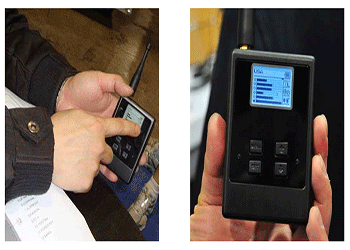GPS Signal Detector Miami Beach Coral Gables

GPS Signal Detector Miami Beach Coral Gables
There are many radio frequency detectors that are effective at finding spy bugs and other invasive equipment. Most present day devices can be detected with fairly inexpensive equipment. It is very important to understand how these detectors work in order to choose one that will detect any likely bugs that you may encounter. Once you understand the general principles of how the bug detector work, you can choose a detector that has the options that you will require to find any bugs you may be likely to encounter.
There are several types of models you can choose from when selecting a spy bug detector. Be wary of models that claim to be an all-in-one device because there is a good chance that some of the functions are inoperable or very ineffective at best. The best type of model to look for is one that has an audio reading, a visual display and has a method to change the frequency that is being searched for. You will also want to purchase a unit that has an external sweep unit to make it easier to search harder-to-reach areas.
Frequency detectors can be used to locate several types of spy equipment. They can be used to detect microphone bugs, wiretaps, video cameras, GPS trackers and laser microphones.
Radio frequencies are given off by nearly all spying devices, and these radio frequencies can be detected with the proper equipment. The most important factor to take into account when choosing a bug detector is finding equipment that repeatedly locates several types of spy devices. Different types of spy bugs give off a large range of frequencies and it is important for your detector to be able to locate as many devices as possible. The larger the range of frequencies detectable, the more likely your detector will locate hidden spy bugs. It is important to find a model that has a good display of the frequency that is being read and the strength that it is reading at.
A GPS device is not only used for tracking and navigating. It can also be used to spy on someone. GPS devices are usually small and can be hidden just anywhere on the subject. If you suspect that someone has placed a GPS tracking device on your car or other belongings there are some countermeasures you can take like getting a GPS signal detector.
Detecting the presence of GPS tracking devices often requires the assistance of a mechanic or you should spend some money buying signal detectors. While not all GPS tracking devices are attached to the vehicle within mechanical parts, if you have recently purchased a used car and wish to find an unwanted GPS tracking device, you should use a radio frequency (RF) detector and have the assistance of a mechanic for visual inspection of the vehicle’s engine and the electrical and mechanical systems.
With a GPS tracking device placed somewhere in your car, someone else can easily monitor your movements. In the US, the FBI uses this method to keep watch on those who have a criminal past or those they are trying to clamp down. If you are not a criminal or you are not in the US, then the FBI has no business with you. But that doesn’t mean someone else cannot track your movement with a GPS device. If you are feeling worried that someone else may be tracking your movement, there are ways by which you can easily find out. Here, It will be explained how you can detect or use a detector to discover a GPS tracker hidden in your car:
First, you must bear in mind that a GPS tracking device would need to “see” the sky in order to work perfectly. Although GPS signals can penetrate plastic materials that are not very thick, they hardly can penetrate metal. So, the device must be placed in a location that will protect it and still provide a fairly direct communication route with the satellites above.

GPS Signal Detector Miami Beach Coral Gables
So, where in your car should you look for a hidden GPS tracking device? You will start from the front and work your way backward to the rear end of the car.
Thoroughly inspect the underside of the vehicle, including wheel wells, axles, running boards and between all crevices and seams under the car. Run your fingers along any areas you cannot clearly see, feeling for any devices or small items that could be placed in hidden areas.
Inspect the Vehicle Thoroughly
When inspecting the vehicle, include the axles and wheels well. Check also the crevices of the vehicle. Those areas that you cannot visibly see, try to run your fingers and feel for small devices that are intentionally placed to track the automobile. GPS devices differ in sizes; some are smaller than smartphones or even as small as a quarter of an iPhone. Some may even look just like usual objects such as a pen, sticks, and the likes, so you better watch out for things like that particularly when you think you’re being tracked.
Finding Passive and Active Trackers
Passive trackers are devices which collect data and store location information in an internal drive. In other words, these are usually small and don’t have wires and cables attached to them. If you see a black box, for instance, try to pull it off. If it opens, chances are, the device is not factory-installed and you should become suspicious that somebody placed it there without you knowing it. This surveillance device is usually hidden in car cushions and headrests, or in very simple tactics, it’s placed somewhere in pockets or pouches.
Active trackers, on the other hand, send real-time information back out to the person who is spying on you. GPS tracking device like these are usually attached to the vehicle’s electrical system, basically to have a consistent power source and longer operating life, and this allows easily for signal detectors.
Though a bit obvious and may not work for a professional covert tracking, you could expect Active trackers to be placed on well-hidden locations such as the vehicle’s fuse box, bumpers, head light covers, and etc.
Using a GPS Bug Detector
Detecting the existence of a GPS tracking device on a vehicle usually requires the aid of another electronic device called a GPS Signal Detector. GPS tracking devices are usually not affixed within metallic parts of vehicles due to signal transmitting issues, so try to check those areas with parts made of what is called as “GPS-friendly” materials such as glass, plastics, foam, and etc. GPS Signal Detectors use a radio frequency signal to “detect” a GPS device or it “intercepts” radio signals being transmitted by the device.
Plug in and turn on the GPS signal detector and set the signal detector to continuously detect outgoing signals, which could be sent from a GPS tracking device on the vehicle. Signals can be sent anywhere from every few seconds to every 20 minutes. If you have turned the GPS signal detector on just after a signal is sent, you may have to wait up to 20 minutes for another signal to be sent. This process can be time-consuming.
While waiting for the GPS signal detector to receive any transmitted signals, inspect the inside of the car thoroughly and completely. Check under the steering column, the dashboard, under gas and brake pedals, under the seats, cushions, and floor mats and under the console. Check ashtrays, even if you don’t smoke.
Although some detectors are sensitive enough to find a GPS bug even when it’s turned off, it’s best to allow some time for the GPS detector to work by waiting for a potential signal to leave a hidden GPS tracker.
Physical inspections to detect GPS
The Wheel Wells
Though it is unlikely that someone places a GPS device in your wheel wells, it’s not impossible. Check all four, look for any strange thing that may look like a box, cylinder, or something else. Only your brakes should be behind your wheels. You should even remove the brakes and look into them (you may find a wire going to a sensor here – don’t touch it). Also, you won’t miss the spiral shaped, load-bearing metal above the wheels. Don’t take these for a GPS tracker.
The rear bumper
Check behind your bumper. Although you may also find some wires here, these are most probably powering lights and external sensors that send you signal while you are driving. Be careful not to remove or disconnect anything while checking for strange devices. If you disrupt any arrangement, your car may fail to start when next you try to move it.
General areas
You should check the car’s undercarriage. Even though a device placed under here may not have smooth communication with GPS satellites, some devices may have strong sensors or antennas that will establish communication through these barriers.
The dashboard area
Though you will be sitting close to this part of your car for most of the time, you may not quickly sense a strange device because there’s a lot of room under that fancy dashboard. Granted, there’s a lot of stuff in there, but there’s a lot of space as well.
For easy access, enter through the glove compartment. It’s even better to remove the compartment by loosening the screws and pulling it out completely. Use a torch to search through it — among the wires. If you notice any strange device that is not connected with any component within the compartment, bring it out and check thoroughly — it may be what you are looking for. After searching through the glove compartment, repeat the search procedure for the driver’s side of the dashboard. If possible, remove the panel under the steering wheel and check it for any strange color.
The consoles (and more)

GPS signal detector Miami Beach Coral Gables
If your car has a sunroof, a GPS tracker can be installed in other locations in the car where it can communicate with the satellites above through the opening in the roof. Check for any strange objects or wires. Open up every place you can (but avoid forcing anything open).
Also, check under your carpets and under the front and rear seats for strange wires. Trace all wires to their sources to confirm that they are not from external sources. While doing this, exercise caution to avoid disconnecting your wires or damaging your seat heating equipment.
Now, what if you found nothing? If you do all these checks and still find nothing, this means nobody is tracking your car. But if you are still not convinced, ask someone else to check for you. If it’s the same story, then you can rest assured that you are not being watched.
Devices that actively transmit your location can be pinpointed with handheld detectors. (Some devices store info for later retrieval, and can hide from these sensors.) If you’re willing to pay a significant price, look for a company that sells Technical Surveillance Counter Measures (TSCM).
The tracker may only transmit occasionally and/or when the car is moving, so test while your friend is driving somewhere remote. (Nearby cell phone transmissions can interfere with the device.)
Spy World is your convenient store to look for everything related to TSCM devices like GPS Signal detector and more. Come to our store we are located in Coral Gables Miami, Florida. Coral Gables is a city in Miami-Dade County, Florida, United States, located southwest of Downtown Miami.
[email protected] / [email protected]
Spy Store Miami & Spy Shop Miami
Miami Beach • Miami Gardens • Aventura • Coral Gables • Doral • Hialeah • Hialeah Gardens • Homestead • Kendall • Key Biscayne • Miami • Miami Lakes • North Miami • North Miami Beach • Opa-Locka • Palmetto Bay • Pinecrest • Pinecrest / Monroe Couty • South Miami • Miami Beach




